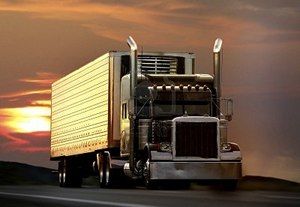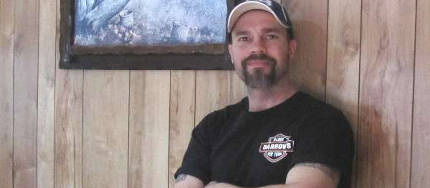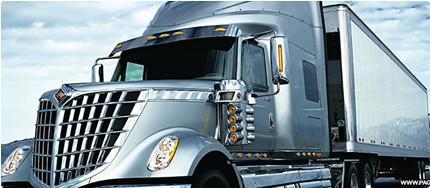Review Questions - Click On The Picture To Begin...

- The heaviest trailer should be the very last trailer
- If there are three trailers, the heaviest should be in the middle
- The heaviest trailer should be in first position behind the tractor
- The position of the heaviest trailer is not important as long as the brakes are working properly
Quote From The CDL Manual:
For the safest handling on the road, the more heavily loaded semi-trailer should be in first position behind the tractor. The lighter trailer should be in the rear.
- Chock the wheels
- If the second trailer does not have spring brakes, drive the tractor close to the trailer, connect the emergency line, charge the trailer air tank, and disconnect the emergency line
- Make sure the trailer spring brakes are locked
- Back another trailer to the rear of the trailer you want to hook to which will act as a brace and keep the trailer from rolling
Quote From The CDL Manual:
- Release dolly brakes by opening the air tank petcock. (Or, if the dolly has spring brakes, use the dolly parking brake control.)
- Make sure trailer brakes are locked and/or wheels chocked.
- A special accessory used to supply hydraulic pressure to the rear trailer brakes
- A special device to indicate any airline failures or leaks in the rear most trailer
- A coupling device of one or two axles and a fifth wheel by which a semitrailer can be coupled to the rear of a tractor-trailer combination forming a double bottom rig.
- An anti-jackknife braking system similar to ABS used in the second and/or third trailer
Quote From The CDL Manual:
A converter gear or dolly is a coupling device of one or two axles and a fifth wheel by which a semitrailer can be coupled to the rear of a tractor-trailer combination forming a double bottom rig.
- Brakes will be released when the electrical cable is attached
- If a dolly doesn't have spring brakes, it doesn't have brakes at all
- Opening the air tank petcock
- Hooking airlines to the dolly will automatically release the brakes
Quote From The CDL Manual:
Release dolly brakes by opening the air tank petcock. (Or, if the dolly has spring brakes, use the dolly parking brake control.)
- Some converter dollies have spring brakes, but dollies are not required to have them
- Converter dollies don't ever have spring brakes
- All converter dollies are required to have spring brakes if built after 1975
- While some states don't require dollies to have spring brakes, it is required for dollies to have spring brakes on the interstate system
Quote From The CDL Manual:
A converter gear or dolly is a coupling device of one or two axles and a fifth wheel by which a semitrailer can be coupled to the rear of a tractor-trailer combination forming a double bottom rig.
- Release dolly brakes by opening the air tank petcock. (Or, if the dolly has spring brakes, use the dolly parking brake control.
- Back first semi-trailer into position in front of dolly tongue
- Lock pintle hook
- Hook dolly to front trailer
- Secure converter gear support in the lowered position
Quote From The CDL Manual:
Connect converter dolly to front trailer:
- Back first semi-trailer into position in front of dolly tongue.
- Hook dolly to front trailer.
- Lock pintle hook.
- Secure converter gear support in raised position
- Back converter dolly under rear trailer
- Make sure trailer brakes are locked and/or wheels chocked
- Connect safety chains, air hoses and light cords
- Close shut-off valves at rear of first trailer (and on dolly if so equipped)
Quote From The CDL Manual:
Connect converter dolly to rear trailer:
- Make sure trailer brakes are locked and/or wheels chocked.
- Make sure trailer height is correct. (It must be slightly lower than the center of the fifth wheel, so trailer is raised slightly when dolly is pushed under.)
- Back converter dolly under rear trailer.
- Raise landing gear slightly off ground to prevent damage if trailer moves.
- Test coupling by pulling against pin of number two semi-trailer.
- Make visual check of coupling. (No space between upper and lower fifth wheel. Locking jaws closed on kingpin.)
- Connect safety chains, air hoses and light cords.
- Close converter dolly air tank petcock and shut-off valves at rear of second trailer (service and emergency shut-offs).
- Open shut-off valves at rear of first trailer (and on dolly if so equipped).
- Raise landing gear completely.
- Charge trailers (push "air supply" knob in) and check for air at rear of second trailer by opening the emergency line shut-off. If air pressure is not there, something is wrong and the brakes will not work.
- Be the middle trailer
- Be the first trailer
- The placement of the lightest trailer doesn't matter
- Be the last trailer
Quote From The CDL Manual:
For the safest handling on the road, the more heavily loaded semi-trailer should be in first position behind the tractor. The lighter trailer should be in the rear.
- Be sure the pintle hook is unlocked
- Move the dolly to rear of first trailer and couple it to the trailer
- Pull dolly into position as close as possible to nose of the second semitrailer
- Wheel dolly into position in front of second trailer in line with the kingpin
Quote From The CDL Manual:
Position converter dolly in front of second (rear) trailer:
- Release dolly brakes by opening the air tank petcock. (Or, if the dolly has spring brakes, use the dolly parking brake control.)
- If the distance is not too great, wheel dolly into position by hand so it is in line with the kingpin.
- Or, use the tractor and first semitrailer to pick up the converter dolly:
- Position combination as close as possible to converter dolly.
- Move dolly to rear of first semi-trailer and couple it to the trailer.
- Lock pintle hook.
- Secure dolly support in raised position.
- Pull dolly into position as close as possible to nose of the second semitrailer.
- Lower dolly support.
- Unhook dolly from first trailer.
- Wheel dolly into position in front of second trailer in line with the kingpin
- The trailer should be a minimum of 1ft higher than the fifth wheel, so the trailer king pin will not strike the fifth wheel plate and cause damage
- The trailer should be slightly higher than the center of the fifth wheel, so the trailer doesn't have to raise up when the dolly is pushed under
- The trailer landing gear should be lowered completely so that you can push the dolly under the trailer and be ready to drive once attached
- The trailer must be slightly lower than the center of the fifth wheel, so the trailer is raised slightly when dolly is pushed under.
Quote From The CDL Manual:
Connect converter dolly to rear trailer:
- Make sure trailer brakes are locked and/or wheels chocked.
- Make sure trailer height is correct. (It must be slightly lower than the center of the fifth wheel, so trailer is raised slightly when dolly is pushed under.)
- Back converter dolly under rear trailer.
- Raise landing gear slightly off ground to prevent damage if trailer moves.
- Test coupling by pulling against pin of number two semi-trailer.
- Make visual check of coupling. (No space between upper and lower fifth wheel. Locking jaws closed on kingpin.)
- Connect safety chains, air hoses and light cords.
- Close converter dolly air tank petcock and shut-off valves at rear of second trailer (service and emergency shut-offs).
- Open shut-off valves at rear of first trailer (and on dolly if so equipped).
- Raise landing gear completely.
- Charge trailers (push "air supply" knob in) and check for air at rear of second trailer by opening the emergency line shut-off. If air pressure is not there, something is wrong and the brakes will not work.







 TT On Facebook
TT On Facebook